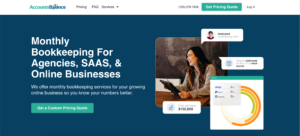
Proper bookkeeping for nonprofits is important in maintaining transparency and accountability. Nonprofits operate on a foundation of trust from donors, volunteers, and the community at large. Bookkeeping plays a vital role in upholding this trust. This way, resources can continue to come in to support projects for positive social change.
Understanding Nonprofit Bookkeeping
Nonprofit organizations, despite their mission-driven nature, still rely on sound financial management. Bookkeeping for nonprofits is the process of recording, classifying, and summarizing the financial transactions of a non-profit organization. It involves activities like:
- Tracking income from donations, grants, fundraising events, and membership fees.
- Recording expenses related to program delivery, administrative costs, and fundraising activities.
- Reconciling bank statements to ensure accuracy.
- Preparing financial reports for donors, boards of directors, and government agencies.
Strong financial management practices make a nonprofit more attractive to potential donors who want to ensure their contributions are used effectively.
GAAP Compliance
Nonprofits do not strictly adhere to the Generally Accepted Accounting Principles (GAAP) that for-profit businesses use. These can serve as a foundation for good accounting practices to ensure transparency, fair presentation, and consistency in financial reporting. Primarily, however, nonprofits follow the Financial Accounting Standards Board (FASB) Accounting Standards Update (ASU) No. 2016-02, “Not-for-Profit Entities (Topic 958).”
Nonprofit accounting places a greater emphasis on demonstrating the impact of an organization’s activities in achieving its social mission. Financial reports should communicate how resources are used to fulfill the organization’s purpose. Nonprofits may value donated goods and services at fair market value, for example. This may differ from historical cost accounting principles under GAAP.
Tax Exemption
Qualifying 501(c)(3) nonprofit organizations are exempt from federal income tax on donations, grants, and most program-related income. However, maintaining tax-exempt status requires ongoing compliance with IRS regulations.
Accurate bookkeeping ensures the organization has the necessary documentation to support its tax-exempt status. Bookkeeping also helps maintain a clear separation between program service activities that fulfill the nonprofit’s mission and unrelated business activities that may generate taxable income. Clear distinction between these activities is crucial for tax purposes. Meticulous tracking of restricted funds is also essential as is proper allocation of expenses to demonstrate responsible use of funds. This strengthens the case for continued tax-exempt status.
Key Components of Nonprofit Bookkeeping

Recording and Tracking Revenue and Expenses
Recording and tracking revenue and expenses ensures responsible stewardship of donated funds. It also facilitates transparent reporting to stakeholders, and allows for informed financial decision-making.
Donations are a common source of income for nonprofits. Nonprofits also often apply for grants to support specific programs or initiatives. Events like galas, charity auctions, or marathons can generate additional revenue. Some nonprofits offer memberships with associated fees to provide benefits or exclusive access to services. Alternatively, nonprofits may generate income through program-related activities, such as selling merchandise or providing fee-for-service offerings.
Bookkeeping for nonprofits mainly tracks three expense types. Program expenses are direct costs associated with delivering mission-based programs and services. Examples include staff salaries, materials used for program activities, and venue rentals for program delivery. Administrative expenses are essential for running the organization but not directly tied to program delivery. Examples include rent, utilities, office supplies, and accounting fees. Fundraising expenses are costs incurred to raise funds, such as marketing campaigns, event planning costs, and staff time dedicated to fundraising activities.
Nonprofits typically use accrual accounting vs cash accounting to recognize revenue and expenses. We recommend that you use a chart of accounts tailored to your nonprofit’s specific revenue streams and expense categories. This ensures consistent categorization of financial transactions. (Here’s a COA template you can build from.) You can also benefit from investing in accounting software designed for nonprofits. These programs can automate tasks, streamline workflows, and generate detailed reports for revenue and expenses.
Managing Payroll
Managing payroll is crucial to proper bookkeeping for nonprofits. If you have any employees, you must ensure accurate calculations for wages. Consider factors like hourly rates, overtime pay, and deductions for taxes and benefits. Timely payouts are also essential for both morale and compliance with labor laws. As a nonprofit, you may not be used to paying employees, so read up on it or get legal advice. For instance, you need to be up-to-date with labor laws regarding minimum wage, overtime pay, and employee benefits.
Consider using payroll software to streamline calculations, automate tax filings, and generate pay slips for employees. Internal Controls: Implement a system of internal controls to safeguard payroll data and minimize errors or fraud. This might involve segregation of duties and regular reviews of payroll reports.
Managing Different Fund Types
Nonprofit organizations juggle various funding sources, namely, restricted, unrestricted, temporarily restricted. Unrestricted funds come with no donor-imposed restrictions on how your nonprofit can use them. Temporarily restricted funds have donor-imposed time restrictions or specific purpose restrictions. This means you can’t use the funds for unrestricted purposes until the time period is over or you fulfill the designated purpose. Restricted endowment funds are permanent donations where you can only use the investment earnings . The principal amount of the donation remains invested in perpetuity to generate ongoing support for the organization’s mission.
Managing these funds effectively is crucial. You must maintain clear and detailed records of all donor restrictions to avoid any misuse of funds. Implement a fund accounting system to segregate and track each fund. This allows for transparent reporting and demonstrates responsible stewardship of donated resources. Develop budgets that allocate unrestricted funds for general operations and temporarily restricted funds for their designated purposes. Make sure the board of directors oversees restricted fund management and ensures ethical fundraising practices.
You should also budget restricted endowment fund earnings for specific programs or activities aligned with the donor’s intent. For temporarily restricted funds with long time horizons and restricted endowment funds, consider prudent investment strategies to grow the fund’s value and maximize long-term returns.
Many accounting software programs designed for nonprofits offer features to track and manage different fund types. These can automate tasks, generate reports, and ensure accurate record-keeping. Donor management systems also come in handy. Use them to track donor information, record restrictions associated with donations, and generate reports on the impact of their contributions. This way, you can easily maintain open communication with donors regarding where their contributions go.
Budget Creation and Management
A well-crafted budget allocates resources strategically to translate a nonprofit mission into actionable financial plans. Budgets also ensure the responsible use of funds.
Start your budgeting process well in advance of your fiscal year to allow for collaboration and review. Engage staff, board members, and volunteers who are familiar with program operations and funding sources. Their input is invaluable for creating a comprehensive and realistic plan. Analyze historical data and research industry trends to develop realistic forecasts for income and consider all potential sources of revenue.
Zero-based budgeting requires you to justify every expense from scratch for each budgeting cycle. It promotes cost-consciousness and can be useful for identifying potential cost-saving measures. Activity-based budgeting allocates costs based on program activities rather than departments. It provides insights into the true cost of delivering each program.
Best Practices in Nonprofit Bookkeeping

Ensuring Compliance
Nonprofits operate under a different set of financial regulations compared to for-profit businesses. Compliance with key accounting principles is vital to proper bookkeeping for nonprofits. A few key bookkeeping principles underpin responsible financial management for your nonprofit.
First, maintain separate bank accounts for your nonprofit’s operating funds and any donor-restricted funds. This transparency demonstrates responsible stewardship of donated resources. Clearly document any specific purposes outlined by donors for their contributions. Then, ensure restricted funds are used only for their designated purposes.
Second, record all financial transactions meticulously, including income sources, expenses, and asset purchases. Income sources can include donations, grants, fundraising events. Expenses can include program costs and administrative costs. Generate regular financial reports such as income statements, balance sheets, and cash flow statements. Prepare clear and informative financial reports for your board of directors, donors, and the public. Transparency builds trust and demonstrates responsible use of resources. Depending on your organization’s size and revenue, annual or periodic audits by a qualified CPA might be necessary. Audits ensure the accuracy of your financial statements and compliance with accounting standards.
Third, implement fund accounting practices to distinguish between different categories of funds, such as unrestricted operating funds, restricted funds, and endowment funds. This ensures clear accountability for how each type of fund is used.
Fourth, establish strong internal controls to safeguard financial data and minimize the risk of errors or fraud. This might involve segregation of duties, regular account reconciliations, and restricting access to financial systems.
Fifth, maintain documentation to support your organization’s tax-exempt status. File the necessary tax forms (typically Form 990) to comply with IRS regulations.
Embracing Technology
In the ever-evolving world of non-profit operations, embracing technological advancements is vital. Tools can significantly enhance efficiency, accuracy, and transparency.
Technology can revolutionize bookkeeping for nonprofits by automating and streamlining workflows. Cloud-based accounting software designed specifically for nonprofits can automate repetitive tasks. This makes tasks like data entry, generating invoices and receipts, and reconciling bank statements so much easier. This frees up valuable staff time previously spent on manual processes. This way, they can focus on core mission-related activities and donor stewardship.
Robust accounting software also offers features to facilitate meticulous tracking of donor-restricted funds. You can categorize funds based on restrictions, ensuring compliance and responsible allocation of resources according to donor intent. Software can further streamline donor management by integrating features for tracking communication history and generating automated thank-you receipts. This strengthens donor relationships and encourages continued support for your cause.
Cloud-based accounting platforms enable real-time access to financial data for authorized personnel, regardless of location. This fosters collaboration between staff, volunteers, and even board members with financial oversight roles.
Accounting software often comes with built-in reporting tools that allow you to generate comprehensive financial reports tailored to your needs. This empowers data-driven decision making, improved budget planning, and increased transparency for stakeholders.
Cloud-based accounting software providers typically employ robust security measures to safeguard financial data. Regular data backups and access controls minimize the risk of data breaches or unauthorized access.
Make sure that you choose software that is user-friendly and scalable to your organization’s needs. It should integrate seamlessly with any existing donor management or fundraising tools you might be using.
Overcoming Common Challenges in Nonprofit Bookkeeping

Nonprofits face unique challenges in their bookkeeping practices compared to for-profit businesses. Many nonprofits operate with lean teams and limited budgets for dedicated bookkeeping staff or sophisticated accounting software. This may mean that you will need to explore volunteer opportunities for bookkeeping tasks. You can also use cloud-based accounting software designed for nonprofits, which are often affordable.
If you do take on volunteers, make sure that you maintain proper documentation. Note that expense reimbursements for volunteers can be time-consuming. Developing clear volunteer expense reimbursement policies can help a lot. Use online volunteer management platforms that streamline tracking volunteer hours and expenses.
Tracking and adhering to specific restrictions attached to donor contributions can be complex. To avoid the pitfalls, you can implement a robust fund accounting system. Clearly document donor restrictions and allocate funds accordingly. use accounting software features that allow for easy tracking of restricted funds.
Integrating financial data from multiple sources like donations, grants, and fundraising events into cohesive reports can be difficult. We suggest that you invest in accounting software with features that allow for data integration from various sources. Use reporting tools within the software to generate comprehensive financial reports for donors and stakeholders.
Nonprofit accounting regulations can be complex and change frequently. Partner with a qualified accountant or bookkeeper knowledgeable about nonprofit accounting and tax regulations. Regularly attend nonprofit accounting workshops or webinars to stay informed about updates.
Don’t forget to perform monthly bank reconciliations to ensure the accuracy of your financial records and identify any discrepancies promptly.
What Is AccountsBalance?

AccountsBalance is a monthly bookkeeping service specialized for agencies & SAAS companies.
We take monthly bookkeeping off your plate and deliver you your financial statements by the 15th or 20th of each month.
You’ll have your Profit and Loss Statement, Balance Sheet, and Cash Flow Statement ready for analysis each month so you and your business partners can make better business decisions.
Interested in learning more? Schedule a call with our CEO, Nathan Hirsch.
And here’s some free resources:
In Summary
By embracing tailored solutions, nonprofits can experience a multitude of benefits in their bookkeeping practices. Increased efficiency, improved accuracy, enhanced transparency, and better data-driven decision making all contribute to the financial health and long-term sustainability of your organization.
Overcoming the challenges of bookkeeping for nonprofits requires a combination of strategic planning, leveraging technology, and seeking professional guidance when needed. By implementing the strategies outlined here, nonprofits can establish efficient and compliant bookkeeping practices. This helps to ensure that you can manage your valuable resources responsibly.








